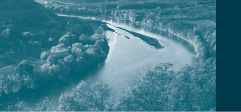Align the state Total Maximum Daily Loads program with local plans for smart growth
Action
Under Section 303(d) of the federal Clean Water Act, states must establish water quality standards for their rivers, lakes and other bodies of water. This includes developing and implementing plans to meet those standards, which include setting Total Maximum Daily Loads (TMDLs) for pollutants.
Waterways that do not meet standards are typically located in developed areas. Directing development to existing communities and to previously degraded land is a key smart growth principle. . It benefits waterways in several ways. First, developed land, such as parking lots, can accommodate new development without increasing impervious surface. When built at higher densities, each extra story of development is built under the same roof. Second, when a vacant site is passed over for a greenfield option, the watershed faces runoff from two sites, not one. Third, even with new green practices, removing forest cover to install green pavers still amounts to a net loss of natural land in the watershed, particularly when off-site roads and access to support the new development are included in the watershed calculation. And most importantly, when redeveloped with "green infrastructure" techniques (such as green roofs), the volume of stormwater runoff and pollutant loadings from redeveloped sites often decreases.
Process
Joint state and local efforts are generating a great deal of innovation by using smart growth techniques to manage TMDLs. Integration of such practices into TMDL programs lead not just to low impacts, but to "positive impacts" on polluted waterways, because they are improved whenever a project or retrofit removes targeted pollutants. States can position programs that reuse impervious cover, retrofit urban tracts and direct growth to higher-density areasas part of a "positive impact" campaign. Because redevelopment and higher-density development can be more difficult to undertake, states can emphasize and encourage "fee in lieu of programs" in instances where on-site practices are impractical.
When developing a TMDL, states can take into account future growth projections and establish a TMDL that accommodates new development activity in areas that already have impaired water quality. According to the Water Environment Federation, few states explicitly account for impacts from future growth. As such, their guidance documents represent an opportunity to include current and future land-use decisions within the TMDL process. For example, communities that take steps — both at the site and regional level — to mitigate the water quality impacts of their growth decisions would go a long way toward achieving target loadings of some TMDLs. States could detail what land-use changes they would like to see implemented, whether it's more compact site designs, transit-oriented development, larger riparian corridors, or larger areas of open space incorporated into the urban and suburban fabric. To encourage communities to act, states could offer them "bonus" points on any applications for Clean Water Act Section 319 or State Revolving Fund (SRF) funding, or for other state funding sources. Although the bonus points would not guarantee a successful application, they would give an advantage to communities that implemented the land-use mitigation measures over communities that did not.
Examples
- Georgia’s TMDL process
As part of its TMDL process, Georgia requires any locality asking the State for an environmental permit that facilitates growth and development (e.g., wastewater and water-withdrawal permits) to conduct a watershed assessment. The assessments provide additional information on point and non-point pollution sources. Applicants must identify pollution sources, model future land-use scenarios, and provide solutions to water quality problems.
— Georgia Department of Natural Resources, Environmental Protection Division


